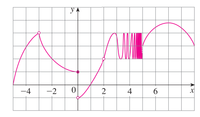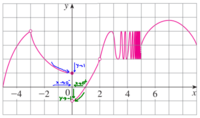You are using an out of date browser. It may not display this or other websites correctly.
You should upgrade or use an alternative browser.
You should upgrade or use an alternative browser.
how do I read this correctly
- Thread starter kory
- Start date
Dr.Peterson
Elite Member
- Joined
- Nov 12, 2017
- Messages
- 16,872
pka
Elite Member
- Joined
- Jan 29, 2005
- Messages
- 11,978
kory, do you see that \(h(2))\) does not exist( not defined)? BUT \(\mathop {\lim }\limits_{n \to 2} \left( {h(x)} \right) = 2~?\)
If \(x\in\) a left-hand neighborhood of zero is \(h(x)\approx 1~?\)
If \(x\in\) a right hand neighborhood of zero is \(h(x)\approx -1~?\)
Thus \(\mathop {\lim }\limits_{\delta x \to {0^ - }} h(x) = 1\quad \& \quad \mathop {\lim }\limits_{\delta x \to {0^ + }} h(x) = - 1\)
If \(x\in\) a left-hand neighborhood of zero is \(h(x)\approx 1~?\)
If \(x\in\) a right hand neighborhood of zero is \(h(x)\approx -1~?\)
Thus \(\mathop {\lim }\limits_{\delta x \to {0^ - }} h(x) = 1\quad \& \quad \mathop {\lim }\limits_{\delta x \to {0^ + }} h(x) = - 1\)
Dr.Peterson
Elite Member
- Joined
- Nov 12, 2017
- Messages
- 16,872
The arrows are what limits are all about. You need to learn to draw your own arrows (or just move your eyes, or your finger, over a graph to think about how the function behaves. Although modern definitions are all about epsilons and deltas and proofs, the original ideas of calculus are about motion, and it's important to be able to imagine that motion.Ok...After looking at your arrows I was able to see it more clearly. I just see dots so its not as clear to me as it is to you guys...
That's one benefit of in-person teachers or videos, where you can see how the teacher is thinking as he moves points around.



